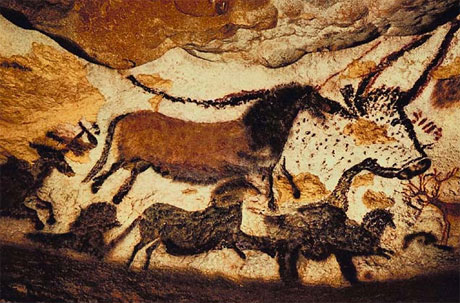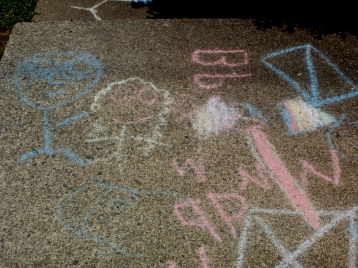For all of our history it has been we ourselves who created art, and perhaps we might even twist Ben Franklin who defined us as a “tool making animal” to say that humankind is an art making animal. Just now we are beginning to have companions and competitors in these acts of creation. Joining us are increasingly intelligent machines- art creating algorithms that are not only already producing art, but are daily getting better at it. It’s a good time, then, to stop and wonder what the rise of these algorithmic artists will mean.
Human beings have been making art seemingly since our very beginning. We didn’t need the rise of complex human societies in the form of cities to create it. Like the lost sketches of our childhood, most of our initial art didn’t make it into the future succumbing to dissolution by the elements, creating a great gap of silence between us and our prehistoric forebears, a fact that made the discovery of the Lascaux caves in 1940 all the more astounding. Today, you couldn’t see the Lascaux caves even if you had the wherewithal to get yourself to southern France- they have been sealed off for the caves’ protection. Modern humans with our numbers and our groping are rightly considered a new form of destructive element that can destroy what it loves through its very curiosity. But, thanks to the miracle of the Internet one can visit the wondrous caves without ever leaving the comfort of one’s home.
What strikes me as question begging in seeing the caves if only in this limited way is just how clearly its artists were versions of us. Their drawings putting me in mind of nothing so much as the chalk sketches of my daughters. And yet, we are so different from these artists in terms of the world we live in and the understanding we have of it that the gap between us is a chasm. Or better, we can understand, even if to a limited extent these artists but were we able to rip them from the past and bring them into the present it is very unlikely that they would ever understand us.
Over and above human biology, what it seems we share most with the artists of Lascaux is the natural desire to create these sorts of representations. No human society has ever existed without art. We are born with the desire to create these strange models of our world. From the moment my daughters could pick up a crayon they were drawing, from the instant they could hit one object off of another they were making music. With sentences came incredible stories and “plays”.
There is a debate currently raging as to whether one form of art, literature, makes us more moral the best response to which I have seen is that it makes us more human. But perhaps we should say more than human. Art, or good art at least, has the capacity to expand human consciousness far out beyond the boundaries of the self and therefore is part and parcel of those other endeavors of our intelligence such as mathematics, science, philosophy, history and religion that allow us to spread out the fabric of our awareness over all that we can see. The creation and even consumption of art is a mark of our intelligence and it can therefore be assumed that as our machines become more intelligent they will become more artistic as well. It is already happening.
Algorithms already shape our artistic choices. A program at Amazon suggests what books you should buy, and similar algorithms at Pandora or Netflix knows your tastes in music or movies as well or perhaps better than you do. It isn’t only that algorithms guide our artistic choices in some cases they are used to decide what gets made or heard.
As pointed out by Christopher Steiner in his Automate This a company like Epagogix is being used by film production companies to decide what movies get made or how much to invest in particular films allowing movie companies to recognize a flop before the director even shouts “action”. (75) Steiner shows us how the same thing is being done for music with a company like Music X-Ray which allows musicians to upload their songs into a huge database that can be searched by music producers for, among other things, potential hits. Lady Gaga and Justin Bieber beware. (87) I have little doubt that similar technologies will eventually be applied to books allowing publishers to find the “Harry Potters” among the flood of manuscripts they receive every day.
In the most basic sense the way in which these film and music sorting algorithms work is that some target criteria is defined, say films grossing over a certain amount, and then the massive data searching capacities of artificial intelligence are applied. At least at this stage technology seems to have empowering potential for individual artists. Their work still exists within a sea of other creations but now at least can be found.
At the moment, on account of its expense, this AI sorting only benefits those producing hits- that is work with the broadest commercial appeal, which most of us hopefully realize is not necessarily the best or most groundbreaking art. We can at least hope that as the cost to create and run these sorts of algorithms decline they will be used to sort for artistic criteria beyond mere commercial appeal.
That’s how algorithms are being used to sort art, but what about actually making it? Music, perhaps because it so closely resembles the mathematics of intelligent machines has been the first to fall here. As only one example: in 2012 on the centenary of Alan Turing’s birth the London Symphony Orchestra performed Hello World! a set of musical pieces composed purely by an algorithm named IAMUS. It does not seem a huge step from algorithms sorting through really big data sets to find hit songs to them being used as tools to allow artists to create hit songs or other productions in the first place or even composing such songs themselves.
The next few decades are likely to experience a tension regarding the question of what these artistic algorithms are actually for? This will not be another version of the tired neo-luddite vs technophile dispute but a debate over how to use technology based on different interpretations of its meaning. Are artistic algorithms tools to help human beings create art and find audiences or are they artists themselves? I have no good answer to the question.
Two seemingly contradictory things seem clear to me. The first is that algorithms and artificial intelligence will further expand the fabric of our consciousness. As Jeff Hawkins put it in a recent interview about the future of AI:
When I ask myself, What’s the purpose of life?, I think a lot of it is figuring out how the world works. These machines will help us do that. Many, many years from now, we’ll be able to build machines that are super-physicists and super-mathematicians, and explore the universe. The idea that we could accelerate our accretion of knowledge is very exciting.
Such expansion seems unlikely to be be limited to our models of the universe, biology or social structure, but will embrace our artistic horizon as well.
The second thing that rings true is that as long as we continue to posses the type of intelligence that defines us as humans we will continue to create art for we are born artists just as we are born scientists and spiritual seekers. How those two aspects of our artistic future resolve themselves is beyond me but perhaps a hint at the major possibilities can be found in the caves of Lascaux.
Perhaps, as in the caves, we will establish places where we can practice our art free from the threat of dissolution that comes from contact with the world. However, the world against which our art will need to be preserved will not be the natural world but what Andrew McAfee calls the New Machine Age we are entering. Art is for human beings to create machines are tools.
Another possibility is that we will have a version of Stanislaw Lem’s Incommunicability Thesis. Machines will become extremely proficient in composing music or perhaps even writing books but they will just be running sophisticated algorithms and have no idea what these productions actually mean. Likewise,for the majority of human beings who are not high level programmers the art the machines create will provide no reflection whatsoever of the internal states, the “thoughts” of the machine. If Lem had been an anthropologist he would have been the strictest of cultural relativists. In this view, not only could the artists of Lascaux never understand us, we could never understand them. You need to live in the worldview of a culture to understand it beyond the level of a nearly empty abstraction.
As a last possibility, maybe the coming age of artistic algorithms will so expand our imaginative horizons that it will appear that our past was nothing more than being trapped in a cave of shadows. That we will have at long last emerged into the sublime brilliance of the light.

 For all of our history it has been we ourselves who created art, and perhaps we might even twist Ben Franklin who defined us as a “tool making animal” to say that humankind is an art making animal. Just now we are beginning to have companions and competitors in these acts of creation. Joining us are increasingly intelligent machines- art creating algorithms that are not only already producing art, but are daily getting better at it. It’s a good time, then, to stop and wonder what the rise of these algorithmic artists will mean.
For all of our history it has been we ourselves who created art, and perhaps we might even twist Ben Franklin who defined us as a “tool making animal” to say that humankind is an art making animal. Just now we are beginning to have companions and competitors in these acts of creation. Joining us are increasingly intelligent machines- art creating algorithms that are not only already producing art, but are daily getting better at it. It’s a good time, then, to stop and wonder what the rise of these algorithmic artists will mean.
 As pointed out by Christopher Steiner in his
As pointed out by Christopher Steiner in his